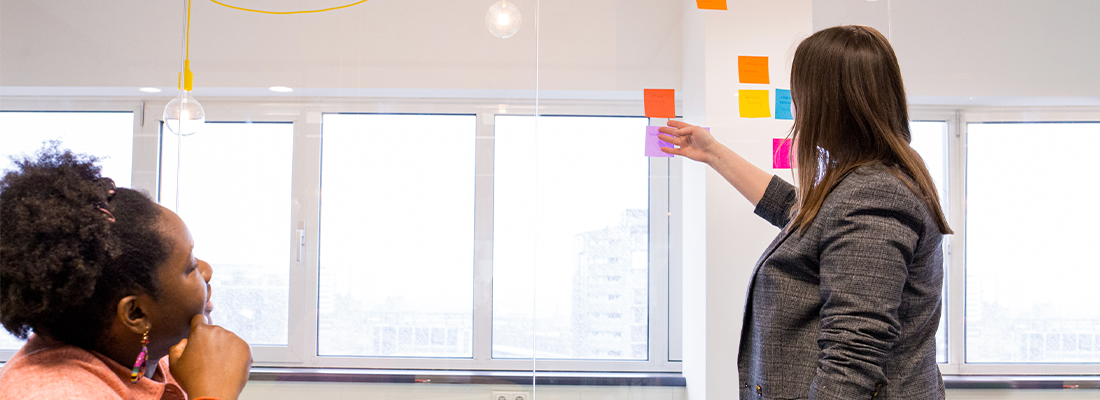Customer Succes Strategy: a win-win for the learning world

“More impact as a training provider, even without adjusting existing courses? It is possible!”
More impact as a training provider, it was one of the subjects that was discussed during the recent Lunch & Learn we organised.
The Dutch and Flemish training providers who were present all had the same solution: focus on the ideal customer and have the guts to only aim your attention at them. By reading the title of this blog, you can probably guess what strategy is built on this approach. Exactly, the Customer Success Strategy.
The strategy in a nutshell
Customer Success has a simple principle: figure out for which customers you can make a difference for and target them as much as possible. This increases your chance of hitting the bullseye with your courses every single time.
What makes it not-so-simple for many? Actually doing what is necessary. You need to have the courage to say ‘no’ to the customers who are not a perfect match for you, even if they would like to work with you. After all, you are only able to increase your impact if you and the potential customer are a perfect fit.
But how do you figure it out? You assess every one of them based on fit criteria you have established yourself before you start your search. Think about possible expectations from these customers, such as technical demands or specific services, and determine which ones are realistic. This way, you’ll create a checklist that you can use whenever you speak to a potential customer.
Are their expectations in line with what you can offer? Then you have found a perfect match.
Time to start
After this, it’s showtime! Your chance to prove yourself begins. To make sure the collaboration becomes an actual success (like the name of the strategy suggests), we advise you to create your very own Customer Success Framework. This is a structured plan that specifies how you are going to achieve the goals of the customer. It starts with the first success (the first value), but eventually focuses on the main goals (the desired outcomes).
Do you want to continue making an impact? Then, it is important to guide your customers proactively towards their main goals. Because, unsurprisingly, these won’t stay the same forever.

Five building blocks for you as a training provider
Do you see potential in this strategy, and do you have the courage it takes to make it a success? Good! To help you out, we’ve created a step-by-step guide as an example.
1. Know what you can offer
It all begins with taking a good look at your own products and services. What do you have to offer and which problems are you able to solve as a training provider? Both parties play a role in the level of success, not just one. This makes a realistic overview of what you can do for a customer crucial.
As soon as this is clear, you can focus on the star of the strategy: your perfect customer.
2. Identify your ideal customer
Before you can actually start your search, it is important to know who that perfect customer is exactly. Don’t forget to use the information from the previous step. A good example is figuring out for which people or organisations your range of courses would be most valuable.
In this step, you identify their characteristics and define your ideal target group. Of course, it is possible that you have more than one. This depends on how broad your range of courses is.
3. Find out what their expectations are
Step two helps to identify the types of people and organisations that could be a fit. Now, it is important to figure out what the exact expectations of the target group(s) are. What are these customers specifically looking for? Think of the details, such as the learning methods and software you use.
4. Determine your own fit criteria
Reality check! You have figured out the general expectations, but which of those are you able to meet? The answer to this question will help you determine your own fit criteria. Look for the similarities between what potential customers could ask for and what you have to offer.
On top of that, it is important to think about what you need from potential customers. An example of this is a minimally required time investment that is necessary to make the collaboration successful. By doing so, you lower the amount of challenges later on in the process.
As soon as you have determined your fit criteria, you can start your quest of finding the perfect customer.
5. Create a Customer Success Framework
Have you spoken to a new lead and are you a match based on the fit criteria? Congratulations, you have probably found your ideal customer! Now it is up to you to make it a successful collaboration. With a Customer Success Framework, you create a clear path towards that success.
Think about what is necessary to achieve the set goals, namely the first value and desired outcomes. Create a clear plan that you are both satisfied with.
Psst… a spare block
Do you have the guts to be very specific? If you are courageous enough to pick a homogenous group, it is possible to figure out distinct wants, needs and challenges. Such a clear-cut target group might feel like a risk, but it does give you an advantage: you are able to adjust your courses to create a perfect fit and live up to all expectations.
The result? You don’t just provide training, but you become a real partner in talent development! Want to get more tips on how to achieve that? Check out our free ebook ‘Successful training companies put the learner first’.

Need a cheat sheet?
In Dutch, we say: it is better to steal a good idea than to think of a bad one. That’s why we like to share our own approach. Not to steal it per se, but to inspire you with a concrete example.
aNewSpring’s fit criteria can be divided into six different categories. By doing this, we get a clear overview of what the biggest opportunities are and where we can expect challenges.
→ Competence fit
What is the company’s background in working with software?
→ Resource fit
What resources does the customer have to make this a success?
→ Experience fit
What services are expected from aNewSpring?
→ Functional fit
What problem is aNewSpring supposed to solve?
→ Cultural fit
What kind of partner does the potential customer expect?
→ Technical fit
What are the customer’s technical requirements?
What about the Customer Success Framework? Ours is designed to prepare and support our customers during the implementation phase. It is focused on achieving the first value and goes through the following steps:
» [1] Desired outcomes
» [2] Implementation map
» [3] Design
» [4] Build
» [5] Launch
» [6] Live
» [7] Measure
Go for the win-win
By only saying ‘yes’ to customers for whom you can make a real difference, both of you benefit greatly from the collaboration. That’s why we at aNewSpring are big fans of this strategy. We love a win-win situation and it became clear during the Lunch & Learn that we are not the only ones.
